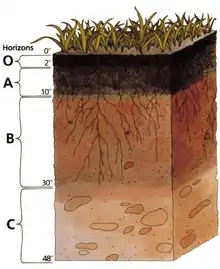Australian Soil Classification
The Australian Soil Classification[1] is the classification system currently used to describe and classify soils in Australia.[2][3] It is a general-purpose, hierarchical classification system, and consists of five categorical levels from the most general to the most specific: order, suborder, great group, subgroup, and family.[4] An interactive, online key is available.[5] The Australian Soil Classification supersedes other classification systems previously developed for Australian soils, including the Factual Key[6][7] (1960) and the Handbook of Australian Soils[8] (1968).
Structure of the classification system
Order level
At the top, most general, level of the Australian Soil Classification, there are fourteen soil orders. They are: Anthroposols, Organosols, Podosols, Vertosols, Hydrosols, Kurosols, Sodosols, Chromosols, Calcarosols, Ferrosols, Dermosols, Kandosols, Rudosols and Tenosols. The character of the soil orders reflects the arid, strongly-weathered nature of the Australian continent.[9]
Suborder level
For the Vertosol, Kurosol, Sodosol, Chromosol, Ferrosol, Dermosol and Kandosol orders, the suborder-level categories reflect the dominant colour of the upper part of the B2 horizon. There are five suborder colour categories, namely Red, Brown, Yellow, Grey and Black. The colour classes have the same names as, but are not directly equivalent to, those used in the Factual Key[6][10] and estimated using a subset of the Munsell Colour System. The full suborder designation then becomes Red Kurosol, Grey Vertosol, for example.
The remaining soil orders have suborder categories that reflect unique characteristics of the given order. For example, the Hydrosol order is split into Intertidal Hydrosols, Supratidal Hydrosols, Extratidal Hydrosols, Hypersalic Hydrosols, Salic Hydrosols, Redoxic Hydrosols and Oxyaquic Hydrosols.[11] On the other hand, the Rudosols are split into Hypergypsic Rudosols, Hypersalic Rudosols, Shelly Rudosols, Carbic Rudosols, Arenic Rudosols, Lutic Rudosols, Stratic Rudosols, Clastic Rudosols and Leptic Rudosols at the suborder level.[12]
See also
References
- "Australian Soil Classification (as Online Interactive Key)". CSIRO. Retrieved 11 February 2016.
- Isbell, Raymond F. (1996). The Australian Soil Classification (1st ed.). Collingwood, Victoria: CSIRO Publishing. ISBN 0-643-05813-3.
- Isbell, Raymond F. (2002). The Australian Soil Classification (Revised ed.). Collingwood, Victoria: CSIRO Publishing. ISBN 0-643-06898-8.
- CSIRO. "How to Classify". The Australian Soil Classification. Retrieved 13 July 2010.
- CSIRO. "Key to Soil Orders". The Australian Soil Classification. Archived from the original on 6 July 2010. Retrieved 13 July 2010.
- Northcote, Keith H. (1960). A factual key for the recognition of Australian soils. Divisional Report No. 4/60. CSIRO Division of Soils.
- Northcote, Keith H. (1971). A factual key for the recognition of Australian soils (3rd ed.). Glenside, South Australia: Rellim Technical Publications.
- Stace, H.C.T.; Hubble, G.D.; Brewer, R; Northcote, K.H.; Sleeman, J.R.; Mulcahy, M.J.; Hallsworth, E.G. (1968). A Handbook of Australian Soils. Glenside, South Australia: Rellim Technical Publications.
- Fitzpatrick, R.W.; Powell, B.; McKenzie, N.J.; Maschmedt, D.J.; Schoknecht, N. (2003). "Demands on soil classification in Australia". In Eswaran, H.; Rice, T.; Ahrens, R.; Stewart, B.A. (eds.). Soil Classification: A Global Desk Reference. Boca Raton, Florida: CRC Press. ISBN 0-8493-1339-2.
- CSIRO. "Colour Classes". The Australian Soil Classification. Retrieved 14 July 2010.
- CSIRO. "Hydrosols". The Australian Soil Classification. Retrieved 14 July 2010.
- CSIRO. "Rudosols". The Australian Soil Classification. Retrieved 14 July 2010.
